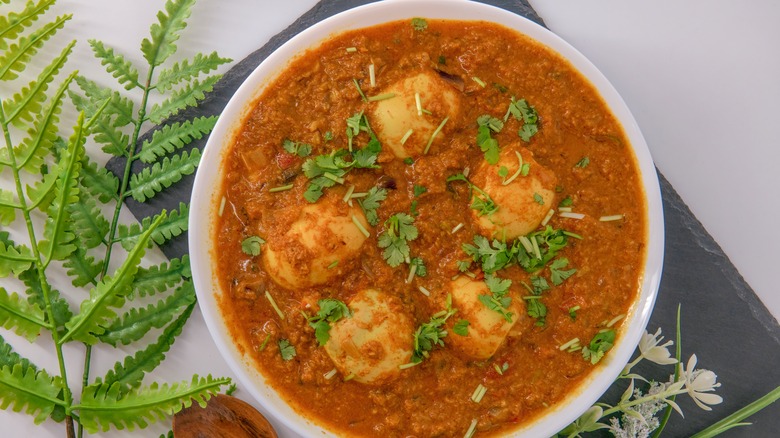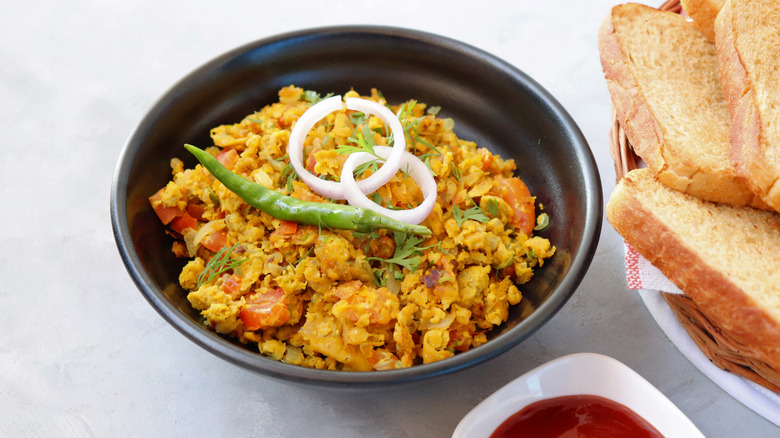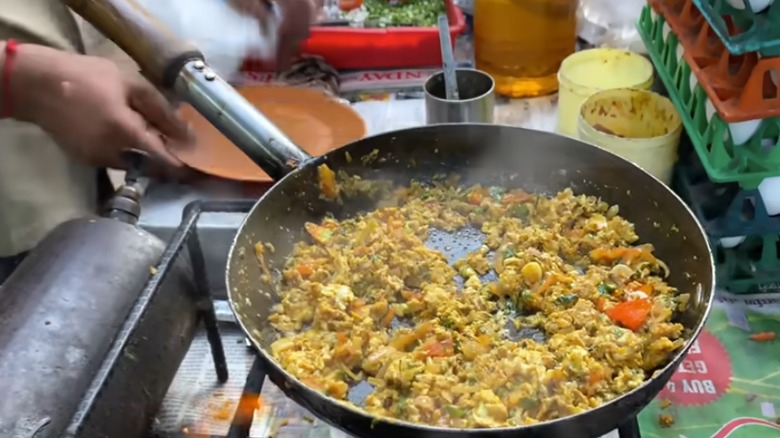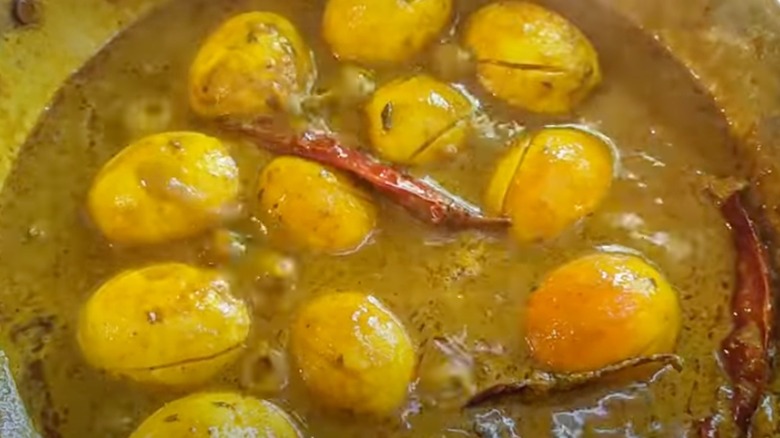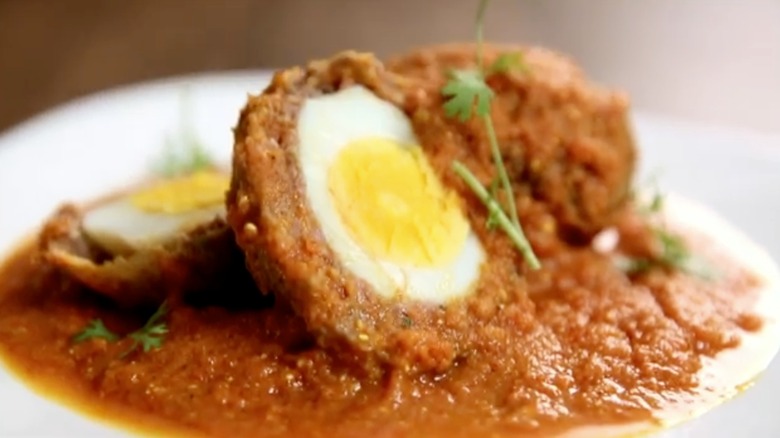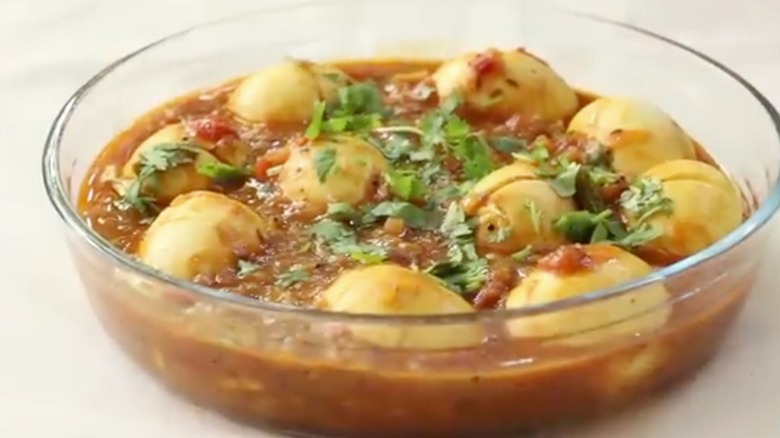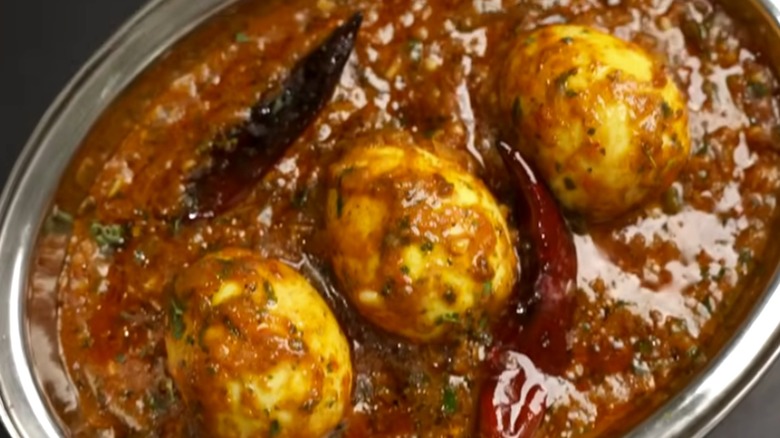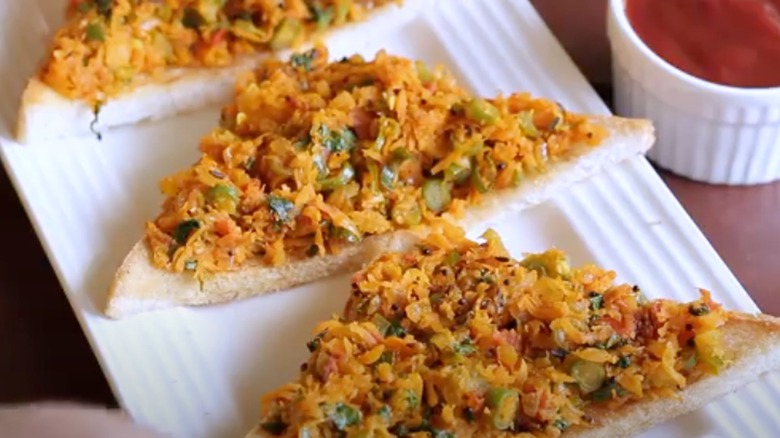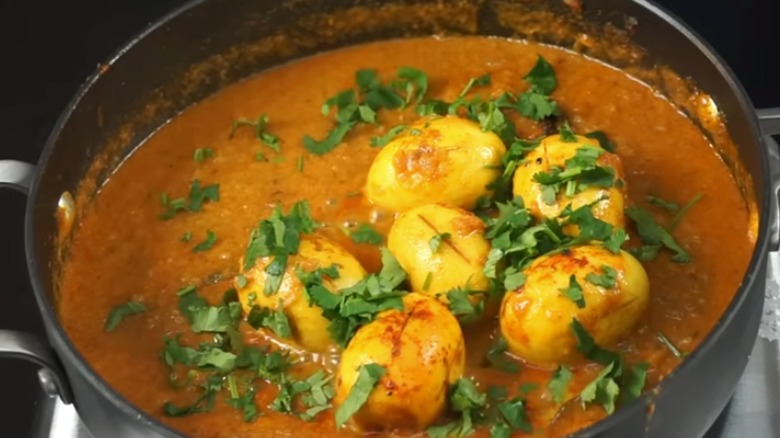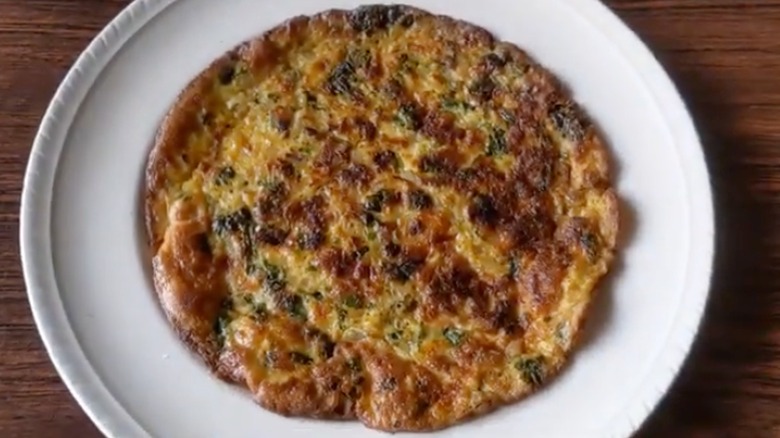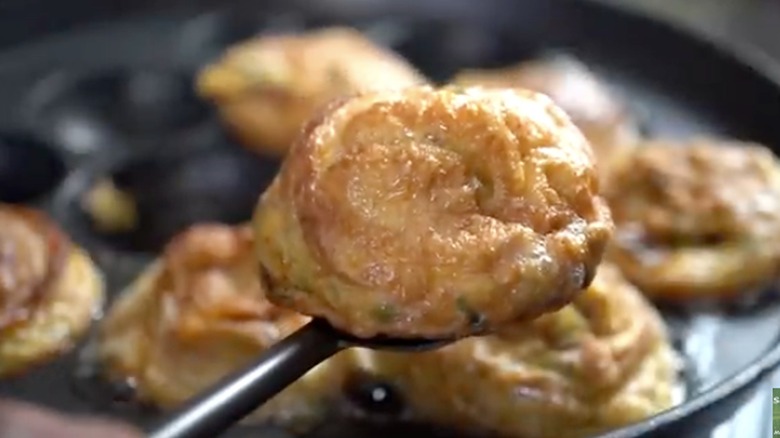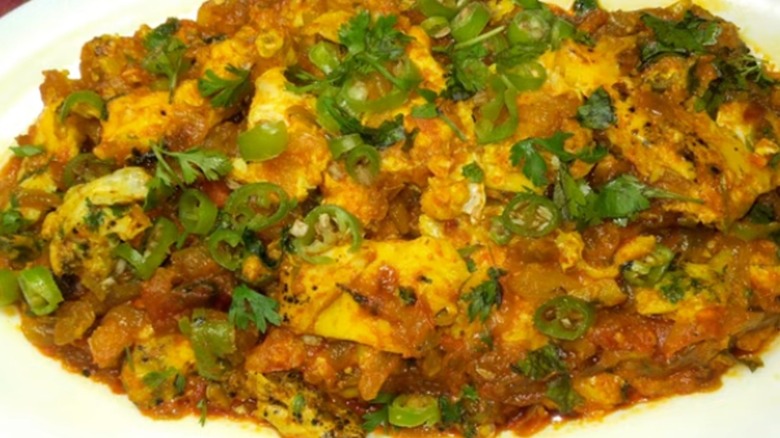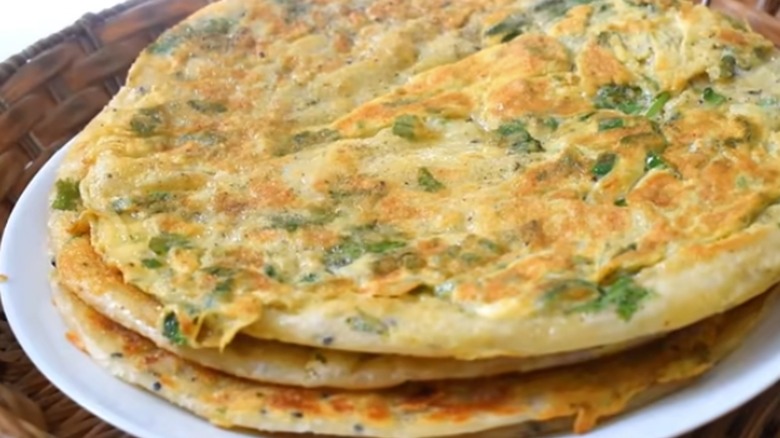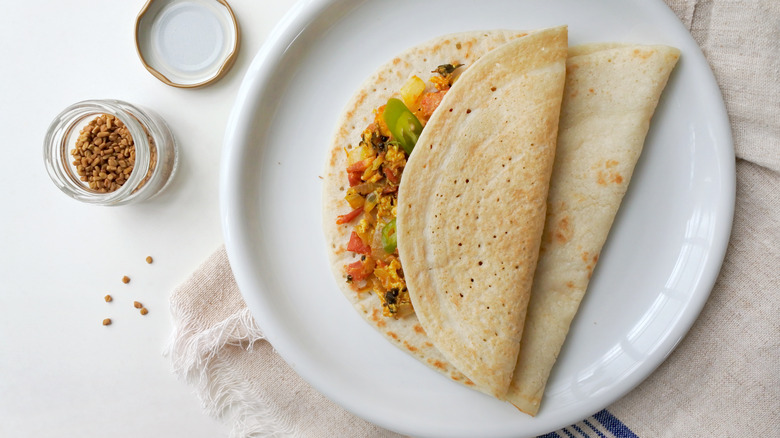14 Indian Egg Dishes Chefs Think Everyone Should Try At Least Once
If you haven't tried the amazing egg dishes India has to offer, you're missing out on some of the best ways to experience this food. Many of the egg recipes you'll find in Indian cuisine were brought from elsewhere and evolved into something completely Indian with the incorporation of local ingredients and spices. While some of the dishes on our list are ones you're more likely to find in Indian homes, others are available at roadside eateries, from street vendors, or at fancy banquets.
We talked to two Indian chefs who shared information about their favorite egg dishes. Monisha Bharadwaj is an Indian food historian, award-winning author, and runs an Indian cookery school. Maunika Gowardhan is a food writer, blogger, and cookbook writer originally from Mumbai. Their favorite egg dishes and others from around the country are featured in our list, representing a brand new world of flavors you're likely going to want to try to expand your culinary palate.
1. Parsi akoori
There are two famous scrambled egg dishes in India that are similar but with regional differences regarding ingredients, texture, and backstory. One of these is akoori. Chef Monisha Bharadwaj describes akoori as "a spicy scrambled egg dish made by the Parsi community of India ... amped up with onions, chillies, ginger, and garlic, tomatoes, and cilantro." Everyone likes to make their own personalized version. Chef Maunika Gowardhan makes hers with turmeric and coriander, and recommends, "This egg dish is best devoured with buttery pav" (a Mumbai-style roll).
Bharadwaj explains, "The Parsis came to western India a long time ago from Iran and brought with them a cuisine that is much loved for its egg, meat, and fish dishes." When the Parsis settled in the Mumbai area around the 8th century, they began making foods that combined their cuisine and techniques with Indian ingredients. You'll find eggs in lots of Parsi dishes, and akoori is probably the most iconic of them all. Bharadwaj notes," It's made in homes as well as small Irani cafes in Mumbai where it's eaten with bread."
2. Anda bhurji (egg bhurji)
Another famous scrambled egg dish in India is egg bhurji. In Hindi, anda bhurji translates directly to "scrambled eggs." There are lots of stories about its origin, but a likely one is that it was made in the state of Gujarat (on the west coast a bit north of Mumbai) for the Mughal Emperor Akbar when he decided to go on a vegetarian kick.
This spicy version of scrambled eggs with onions, chillies, garlic, ginger, and various spices is popular all over India. When we asked Chef Monisha Bharadwaj the main difference between the two scrambled egg variations, she explained that "akoori is creamier and softer than bhurji, where the eggs are cooked to a firmer texture." Bhurji calls for fast-cooking the eggs over high heat rather than slow-cooking them over low heat like akoori.
While plenty of people eat egg bhurji at home in India, it's also available in restaurants and at street stalls, where it's a favorite for hungry customers. One Mumbai bhurji vendor uses 14,000 eggs a week. Depending on where you're eating the dish, it can be served with a variety of breads like roti, rice, or turned into sandwiches or kathi rolls (kind of like an Indian version of a breakfast burrito). Some people even cook it with potatoes.
3. Baida curry (egg curry)
Chef Monisha Bharadwaj describes baida curry as "a simple egg curry made in Indian homes all over India." Both "anda" and "baida" are words used for eggs in Hindi, so you might also hear it referred to as anda curry. There are lots of variations depending on who's making it and where, but the one Bharadwaj likes most is a "north Indian version that has a base of onions, ginger, garlic, tomatoes, spices, cilantro, and dried fenugreek."
Baida curry is a dish you're especially likely to find in Indian homes. Bharadwaj shares, "To me, food is all about memory and this curry was served to me when I was very hungry one night while visiting New Delhi with my mother. I've often cooked it in my kitchen in London when I've craved comfort food and enjoyed it with hot rotis or flatbread."
Even though you can now find versions of this dish all the way down to the Southern tip of India, egg curry originated in Awadh, in the Northern area of the country. The first renditions used boiled eggs wrapped in ground mutton and fried (similar to Scotch eggs). However, many of today's versions use plain eggs. While the modern base is the same and made with onions, garlic, ginger, and tomatoes, the spices tend to vary. Some people even finish it off with coconut milk. It's served with a variety of Indian breads, rice, or in dosas, a thin savory crepe.
4. Nargisi kofte
The mutton-covered egg curry that was the origin of baida curry didn't fall out of favor. Instead, it became known as nargisi kofte. Chef Maunika Gowardhan describes this Indian egg dish as "Spiced minced lamb koftas encased with a boiled egg and steeped in a creamy gravy." The sauce has an onion and tomato base with ginger, garlic, and plenty of spices. The rich texture comes from cream and ground cashews incorporated into the sauce.
Gowardhan says that nargisi kofte is "[a] classic recipe from the north of India and historically served for banquets and celebrations." The name comes from the Persian word for the narcissus flower. The dish was first popular with Mughal royalty, who ruled in Northern India from the 1500s to the 1800s. The Mughals brought a lot of Persian dishes into India, like biryani and kofta, but it's not quite clear where nargisi kofte originated.
Some think it was inspired by Scotch eggs, however, the reverse is more likely, as British soldiers probably brought the idea home from India. Scotch eggs themselves have multiple origin stories, including the Fortnum & Mason department store claiming to have created them in 1738. Meanwhile, nargisi kofte seems to have origins that go back as far as the 1500s or 1600s in Mughal courts. So, it appears that nargisi kofte came first.
5. Andhra egg curry (egg pulusu)
Andhra Pradesh, along the Southeast coast of India, has a distinctive dish known as Andhra egg curry (also called egg pulusu, kodi guddu pulusu, or Andhra pulupu kurallu). Chef Maunika Gowardhan names this her favorite egg curry variation in the country. Pulusus are special because they're all tamarind-based curries, which gives them a distinctive tangy flavor and depth.
According to Gowardhan, "Most curries from this region are known to be spicy. And this one is a regional favorite but also mildly spiced." The recipe contains ingredients like ginger, curry leaves, chillies, coconut milk, tomatoes, tamarind, and a variety of spices. Gowardhan explains, "The creaminess of the eggs and coconut milk balance the spices in the gravy." Plus, the tamarind adds an interesting tangy flavor.
Many cooks also add jaggery (an unrefined cane juice sweetener) which lends the dish a sweet flavor. While regular hard-boiled eggs are common, Gowardhan likes to halve hers so that they soak up more of the sauce. This curry goes well with rice, naan, potatoes, or anything you can use as a carrier for the delicious sauce.
6. Dhaba-style egg curry
Another distinctive Indian egg dish you should try is dhaba-style egg curry. The word "dabba" in Hindi means "lunch box." However, dhabas are also roadside cafes that feed hungry truck drivers and other travelers on their treks across the country. They generally serve Punjabi cuisine, which pulls from various Asian and Middle Eastern cultures that used to travel the ancient caravan routes. Dhabas were traditionally located in simple shacks or mud huts and used earthenware tandoor ovens to cook food over a charcoal fire. These days, there are plenty of fancier modern dhabas.
Something that distinguishes this dish from other egg curries is its smoky flavor from having been cooked over an open fire. Plus, the gravy is made with plenty of oil and spices. Some home cooks cut the amount of oil in the dish to be healthier. Otherwise, it's similar to other tomato-and-onion-based egg curries that feature garlic, ginger, and chili peppers, as well as spices like turmeric, cinnamon, chili powder, cardamom, cumin, coriander, and garam masala. One aspect that sets this dish apart is it doesn't tend to use any creamy dairy ingredients, since the original roadside dhabas didn't have refrigeration available.
7. Masala toast (Bombay toast)
You've probably had sweet French toast before, but have you ever thought about making a savory version? Indian cuisine has a tasty variation, since there is a preference toward savory rather than sweet breakfast dishes. Chef Monisha Bharadwaj describes masala toast as being "jazzed up with green chillies, cilantro, salt, pepper, and turmeric. These are beaten with the eggs, the bread is dipped into the mixture and then pan fried in oil or butter."
Although masala toast is often served as a breakfast dish, Bharadwaj notes, "One could make it more of a lunch dish by adding toppings like tomatoes, cheese, or even spiced potatoes!" Indians don't limit masala toast to breakfast and brunch; some people eat it as a snack food, too.
The dish was developed in Mumbai, pulling in ingredients from across India and various cultures who visited or settled in the port city. In Mumbai, it's known as Bombay toast and served as a street food with numerous varieties across the city. Beyond the streets of Mumbai, you can find it in people's homes as well as at the Iyengars Bakery chain in South India.
8. Muttai kulambhu
Muttai kulambhu is an egg curry that originated in Tamil Nadu in the South of India. In the Tamil language, "muttai" is the word for egg, while "kulambhu" (or "kuzhambu") means gravy. Chef Monisha Bharadwaj decribes, "This delicious South Indian egg curry has boiled eggs in a creamy, spiced coconut curry." She compares this style to what you'll find in other regions of the country and explains, "South Indian curries are often more spiced than North Indian ones as South India grows so many spices."
This dish doesn't skimp on the spices, and Bharadwaj lists: "... peppercorns, cloves, cinnamon, turmeric and fennel seeds that are cooked with onions, ginger, garlic and coconut to make a fragrant base." Rather than coconut milk, this recipe calls for a fresh coconut paste or shredded coconut, which gives the sauce a thicker and more robust texture. Some people poach eggs in the sauce, and others just add hard-boiled eggs.
While it's possible to find muttai kulambhu in food shacks along the roadway, you're probably more likely to eat it in an Indian home. Bharadwaj says, "You'd eat this with rice ... with maybe a poppadom on the side to add texture to the meal."
9. Parsi poro (masala omelet)
While most of us think about omelets as being French, they seem to have originated in ancient Persia. You'll find Indian-style omelets under several names: masala omelets, Parsi poros, or Parsi omelets. The Parsi-Irani community has lived in Western India since the 800s and uses eggs in lots of dishes, with the most popular being akoori and Parsi poro.
Chef Maunika Gowardhan shares that masala omelets are "A weekend brunch staple at our home and loaded with fresh coriander, chillies, turmeric." Other recipes add ginger, garlic, chili powder, cumin, and other ingredients like green onions and tomatoes. With the ingredients all incorporated into the beaten eggs rather than stuffed inside a folded omelet, the dish looks more like an original Denver omelet or egg foo young. "I love serving it with green chutney, parathas, and chai," Gowardhan suggests.
While people make masala omelets at home in India, they're also commonly sold as street food. Mumbai street vendors have gone a step further and created toasty omelet sandwiches by cooking sliced bread into the omelet.
10. Karandi muttai (Karandi omelet)
While Parsi poros are thin, karandi muttai are more like an egg omelet cake. They may have some of the same ingredients, but their thick consistency turns them into something like a personal-sized frittata. These originated in Tamil Nadu in Southern India as a convenience food, and you'll find them available from street vendors throughout the region, who often serve them on a banana leaf. However, you can also find them in restaurants.
The word "karandi" is the Tamil word for "ladle," which street vendors use to mix the ingredients and cook the omelet. The type of ladle the street vendor uses has an effect on the shape and size of the finished product. Some restaurants use special molded pans instead so they can make them in bulk. The eggs are cooked in a contained space like a ladle, small pan, or cooking mold, which gives the mixture layers and helps keep it fluffy. Typical ingredients include onions and green chillies. Like the omelets we've come to enjoy in the West, these sometimes get extra ingredients like cilantro, tomatoes, mushrooms, and even meat. They often also include spices like chili powder and turmeric.
Karandi muttai are commonly served for breakfast and snacks. However, they're just as likely to show up at a other meals, where they're served with rice, biryani, dal or lentil curry, a traditional South Indian soup called rasam, or a thin tomato curry.
11. Hyderabadi anday ka khagina
Moving into the heart of India, you'll find Hyderabadi anday ka khagina. Dishes from Hyderabad are known for being infused with heat and bold spices. There are several dishes in India called "khaginas." In Hyderabad, rather than the eggs being scrambled or boiled, they're poached in a spiced tomato sauce and then turned over to cook more fully. Some cooks drop individual whole eggs into the mixture while others mix the eggs with the whites before dropping them in.
The word "anday" means "eggs" in Urdu, and "khagina" comes from the Persian word for a type of sweet omelet called "khag." Like so many Indian egg dishes, this one is likely Persian in origin or at least Persian-inspired. While this version is a savory dish, sweet khaginas show up in Persian literature as far back as the 1200s.
When you taste this, you're probably going to be reminded of the North African egg dish, shakshuka, or the Turkish egg dish, menemen. Like these two recipes, anday ka khagina involves cooking eggs in a mixture of onions, tomatoes, garlic, and spices like chili powder, turmeric, and coriander. However, some cooks get the red color from peppers and chili powder rather than tomatoes. It's topped with cilantro and often served with sides like rice, dal, and Indian flatbreads like chapati, roti, or paratha. While you're certainly going to find this dish in Hyderabadi homes, it's also a common street food in the region.
12. Anda paratha
Anda paratha is a common Indian street food that originated in Northern India but is now popular across the country. It's another dish you might find on the road in a dhaba while traveling. In Urdu, the name simply means an egg flatbread. A standard paratha is a flakey layered flatbread made with wheat flour. However, an anda paratha consists of a cooked paratha dropped on top of an omelet along with veggies and simple spices to finish it off. Some people manage to cook the eggs between the paratha layers so that it's more like an omelet-stuffed flatbread.
It's perfectly fine to eat anda paratha as you would an omelet. However, you can also use it as a wrap and stuff it with salad ingredients, grilled meat, or keema (minced meat curry). Some people also roll it up and dip it in their favorite sauce or chutney.
13. Ande ka dosa (egg dosa)
Ande ka dosa (egg dosa) is a concept similar to anda paratha in that it has bread on one side and egg on the other. In this case, one side is a thin, yummy dosa — a fermented crisp Indian savory crepe — while the other side is cooked with a layer of egg. Dosas are part of South India's cuisine and have been evolving for years. Tamil scholars have found them mentioned in literature as early as the 500s. These days, you can eat them all over India. With so many years to develop, it's no wonder there are plenty of variations, such as egg dosas.
Anywhere you find street vendors making dosas, you can search for egg dosas. While dosas tend to be a breakfast food in homes, you can find them on the streets at any time. Some egg dosas are fairly simple, marrying an egg and a dosa without too many other frills. However, others add thinly-sliced veggies to the egg component. It's also not uncommon to find the eggs covered in chutney, spices, or even curry.
14. Egg pakora (egg bonda)
In Indian cooking, pakoras (or bhajis) are fritters made by dipping vegetables or meat in a spicy chickpea batter and frying them. An egg pakora (or egg bonda) is a spicy battered and fried hard-boiled egg (either halved or whole). The crispy exterior makes a striking contrast against the soft center. While hard-boiled eggs are most common, some cooks leave them soft-boiled for a jammy egg pakora experience.
Egg and other types of pakoras have been a part of Indian cuisine for a long time, featuring in the meals of the royal Mughal court. Back then they were called "pakkawat," which is a Sanskrit word that means to cook ("pakwa") small pieces or lumps ("vata"). Still, the idea was much the same as it is today. Egg pakoras are common street foods and also served as appetizers or as a side dish. They're also excellent for dipping into your favorite sauce or chutney.
